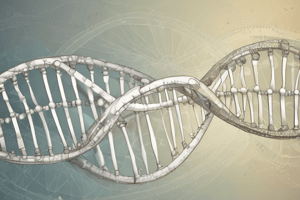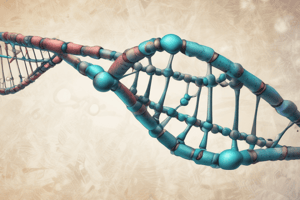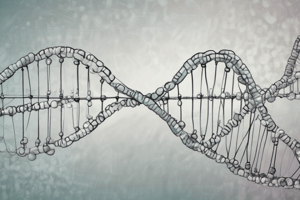Podcast
Questions and Answers
What is the primary function of DNA within a cell?
What is the primary function of DNA within a cell?
- To provide energy for cellular activities
- To act as a structural component of cell membranes
- To initiate cellular respiration
- To carry instructions for all cell processes (correct)
How does the structure of DNA enable its compact packing?
How does the structure of DNA enable its compact packing?
- With the wrapping of DNA around nucleosomes (correct)
- By existing only in prokaryotic cells
- By forming double helices
- Through the use of ribosomes
Which of the following statements about a genome is true?
Which of the following statements about a genome is true?
- It contains only coding regions of DNA
- It is identical across all species
- It is the complete set of DNA in an organism (correct)
- It is present only in prokaryotic organisms
What is a karyotype used for?
What is a karyotype used for?
What do genes encode?
What do genes encode?
Which statement about LUCA is accurate?
Which statement about LUCA is accurate?
What is the relationship between chromosomes and DNA?
What is the relationship between chromosomes and DNA?
What is the size range of genes in terms of DNA bases?
What is the size range of genes in terms of DNA bases?
What is the total length of uncoiled DNA in the human genome?
What is the total length of uncoiled DNA in the human genome?
How many genes do humans have approximately?
How many genes do humans have approximately?
What type of bond holds nucleotides together in DNA?
What type of bond holds nucleotides together in DNA?
What does the term 'epigenetics' refer to?
What does the term 'epigenetics' refer to?
What is the significance of SNVs and SNPs in the human genome?
What is the significance of SNVs and SNPs in the human genome?
What does the term 'epigenome' mean?
What does the term 'epigenome' mean?
What is the main function of the energy derived from phosphodiester bonds in DNA?
What is the main function of the energy derived from phosphodiester bonds in DNA?
What does it mean when it is stated that humans are 99.9% the same?
What does it mean when it is stated that humans are 99.9% the same?
Flashcards
Molecular Genetics
Molecular Genetics
The study of DNA's structure, cellular activities (like replication), and how it shapes an organism.
Nucleic Acid (DNA)
Nucleic Acid (DNA)
A polymer of nucleotides; carries instructions for cell processes.
Chromosome
Chromosome
A tightly coiled DNA molecule, supported by proteins (histones).
Nucleosome
Nucleosome
Signup and view all the flashcards
Gene
Gene
Signup and view all the flashcards
Genome
Genome
Signup and view all the flashcards
Karyotype
Karyotype
Signup and view all the flashcards
LUCA
LUCA
Signup and view all the flashcards
Human Genome Size
Human Genome Size
Signup and view all the flashcards
Human Gene Number
Human Gene Number
Signup and view all the flashcards
DNA Nucleotide Structure
DNA Nucleotide Structure
Signup and view all the flashcards
DNA as an Acid
DNA as an Acid
Signup and view all the flashcards
Single Nucleotide Variants (SNVs)
Single Nucleotide Variants (SNVs)
Signup and view all the flashcards
Epigenetics
Epigenetics
Signup and view all the flashcards
Alleles
Alleles
Signup and view all the flashcards
Genome Similarity
Genome Similarity
Signup and view all the flashcards
Study Notes
Molecular Genetics
- Molecular genetics is the study of DNA structure, cellular activities (including replication), and its role in determining an organism's overall makeup.
History of DNA
- 1868: Friedrich Miescher, a Swiss physician, was interested in the cell nucleus's composition.
- 1920s: Phoebus Levene studied the chemical composition of DNA.
- 1928: Frederick Griffith discovered the transforming principle.
- 1944: Avery, MacLeod, and McCarty confirmed DNA as the transforming principle.
- 1949: Four nitrogenous bases (purines and pyrimidines) were identified.
- 1950s: Franklin, Watson, and Crick used X-ray crystallography to develop the double helix model, with phosphates on the outside.
- 1952: Hershey and Chase determined DNA as the hereditary material.
- 1950: Chargaff's ratios of nitrogenous bases (A-T, C-G) played a critical role in understanding DNA structure.
- 2003: Human genome released.
- 2012: CRISPR developed as a gene editing tool.
- 2020: Complete human genome mapped.
LUCA (Last Universal Cellular Ancestor)
- LUCA represents the last universal cellular ancestor.
- The Tree of Life shows the evolutionary relationships among all organisms.
Gene Ontology (GO) and Protein Domains
- Gene ontology (GO) expansions and innovations are associated with conserved protein domains.
- Conserved domains between species are used to determine associated GO terms.
- GO terms in black are associated with protein domains conserved across eukaryotes, archaea, and bacteria.
- GO terms in blue are associated with Pfam domains not shared by humans and archaea or bacteria.
DNA Structure and Organization
- DNA is a nucleic acid; a polymer of nucleotides.
- DNA in eukaryotic cells is in the nucleus; in prokaryotes, it's in the cytoplasm.
- DNA's structure is coiled; supported by histones (proteins).
- A nucleosome is 8 histones wrapped by DNA, allowing for compact packing.
- Genes are segments of DNA that code for proteins.
- Genes vary in size, from a few hundred to over 2 million DNA bases.
The Nucleus, Chromosomes, and Genes
- The nucleus contains chromosomes, which, in turn, contain DNA.
- DNA comprises genes.
- Deoxyribonucleic acid (DNA) is made up of ACTG nitrogenous bases.
Genome
- A genome is an organism's complete set of DNA.
- The human genome was completely mapped in 2020.
- Humans have a large number of genes.
Molecular Level Details
- DNA is a double helix.
- Nucleotides are the building blocks of DNA (phosphate, sugar, bases).
- Purines (A, G) have a double ring; pyrimidines (C, T) have a single ring.
- Hydrogen bonds connect base pairs (A-T, G-C).
- Phosphodiester bonds create the DNA backbone.
- DNA is antiparallel.
- The major and minor grooves are crucial for protein recognition and binding.
Epigenetics
- Epigenetics refers to functional changes to the genome affecting gene expression without altering DNA sequence.
- Epigenetic changes can be rapid and dynamic or persistent and heritable.
- Differences in identical twins can be linked to epigenetic changes.
Blockchain and Genomes
- Blockchain technology can be used to secure and store genomes.
Studying That Suits You
Use AI to generate personalized quizzes and flashcards to suit your learning preferences.




